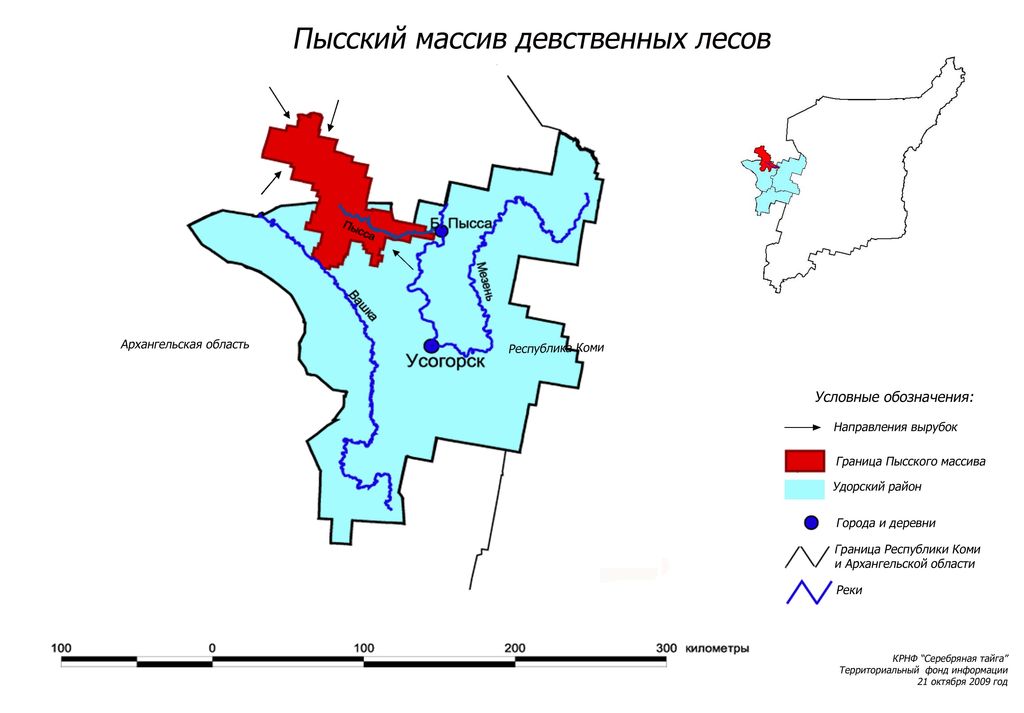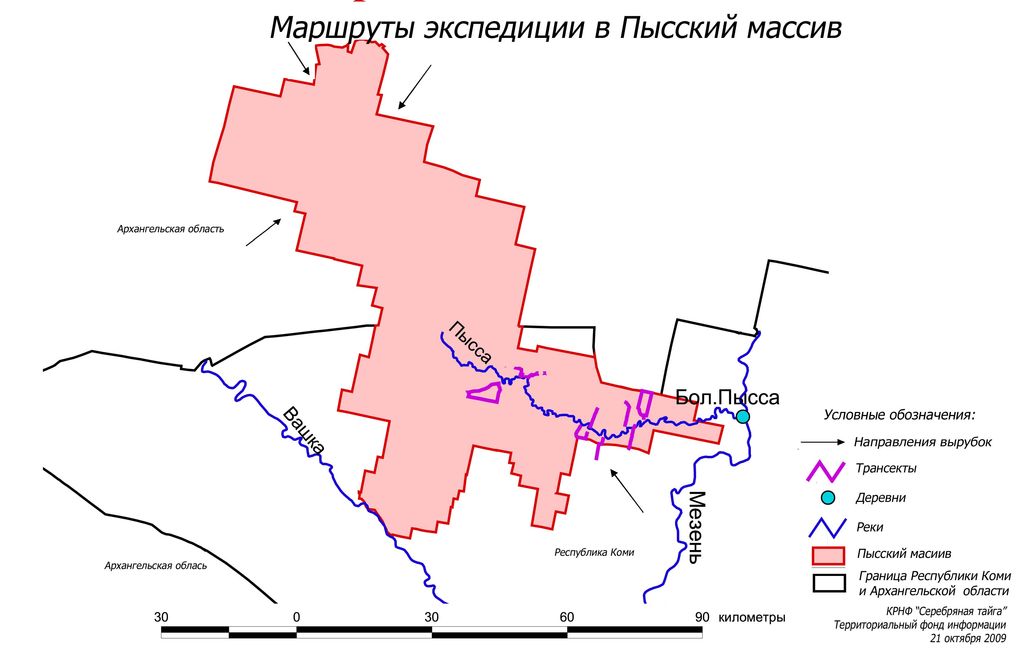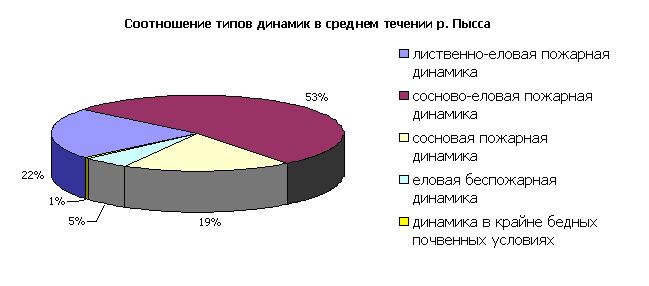«High Conservation Value Forests» project
Pyssa pristine forests massif is situated in the north of the Udora region in the basin of the river Pyssa (the first-order tributary of the Mezen) in the northern taiga subzone and partly in the Arkhangelsk region.
Pyssa pristine forests massif is one of the last large low-disturbed forest territories in the European part of Russia, which was marked by the non-governmental nature conservation organizations (see “Atlas of the low-disturbed territories of Russia”, Aksenov etc., 2003). According to the requirements of the Russian National FSC standard put into effect in November of 2008 such forest massives fall into the category of High Conservation Value Forests (HCVF of the second type), as they present a large forest landscape where viable populations of the most, if not all, biological species represented on this territory exist in their natural state. Such forests require special attention within the voluntary FSC certification for the long-term conservation of their ecological value.
During the periods from the 30th of May till the 7th of June, 2007 and from the 17th till the 27th of August, 2009 the “Silver Taiga” Foundation organized research expeditions along the river Pyssa (see map 2). At the present moment employees of the “Silver Taiga” Foundation are preparing a detail description of the Pyssa valley.
Please, find below general findings and conclusions.
Relief
The confinedness of the territory under study to the basin of the Pyssa determines quite a typical relief. The floodplain of the length from several meters up to 200 meters is changed by the pine-forest terrace. An ascent to the pine-forest terrace is smooth and without any bends. As one moves away from the floodplain and gets closer to the watershed the one can notice increasing amount of sandy hills of the heights 5-20 meters covered with lichen pine forest. Most probably these are glacier eskers with the waterlogged lowlands between them, which formed due to the ground water discharge. These lowlands are usually occupied by the spruce. Slopes to the lowlands are normally smooth and waterlogged along the whole length; they are covered with pine trees on the swamps.
On the inspected territory upland and transitional type swamps, sphagnum and buck-bean sphagnum ones are commonly found, accordingly large amount of Rubus chamaemorus and Betula nana are growing there. The swamps are not slough and they are easily passable in a dry weather. The swamps frequently mark the beginning of the streams
Natural dynamics
The landscapes variety in the Pyssa valley determines the diversity of the vegetation types. A typical dynamics change when moving away from the river is represented by the transition from non-fire coniferous to deciduous-coniferous and then to pine-coniferous forests. On the top of the hills the pine fire dynamics is the dominating one. Percentage ratio between the types of dynamics in the middle and upper reaches of the river Pyssa have significant differences.
Anthropogenic impact
At the present moment major part of the territory under study is low-disturbed (pristine). The part of the pristine forests amounts to 72% in the middle reach and 47% in the upper reach of the Pyssa. In the partially disturbed forests there are indications of the selective cuttings of various intensity performed during the pre-war and war time, as well as the cuttings of the 50-60s. These were mainly pine and less frequently larch selective cuttings. The trees of the highest quality out of the generation which is now 200 years old have been selected. Logging intensity was defined by the amount of the high-quality trees of this generation. Piece selection of the trees and the logging technology (hand felling and horse hauling) didn’t cause any violation of the natural dynamics and reduction in biodiversity on the inspected territory.
Almost the whole length of the Pyssa valley is used for the traditional nature management by the population of the local villages. On the territory of the massif there are many hunters’ putiks (paths in the forest areas rich in berries and game), where the local hunters put their traps for birds and game. Putiks normally begin from the hunters’ lodges, which are mainly situated along the streams and rivers. Lodges are carefully looked after and maintained in a good condition. Traditional nature use plays a great role in the life of the local population, because it’s the only occupation for many villagers.
At the present time logging is getting closer to the borders of the Pyssa massif from the south-eastern and northern directions. In the northern part (on the territory of the Arkhangelsk region) logging is carried out on the border of the massif. On the inspected territory from the south-eastern side logging has reached the southern border of the Pyssa reserve, and in the western direction the road and the logging are located in the distance of 2 km from the border of the core (see maps 1,2). Thus, along the cut-through between the 1st and 2nd quarters of the Chimsky district forestry unit GU “Ertomskoye forestry unit” there is a secondary truck road. On both sides of this road there are clear cuttings performed chequerwise in the years 2008-2009. Logging sites of about 50 ha are adjacent to the road by their short side. On the logging sites of 2009 the harvested wood is kept in stacks, and the share of the sawing logs is approximately 20%. The secondary truck road leads to the wood hauling road of the east-west direction, the survey of this road was conducted up to 880th quarter of the Vazhgortskoye district forestry unit GU “Ertomskoye forestry unit”. This means that the further development of the massif is planned.
Ecological value of the massive
A significant size of the Pyssa massif contributes to the conservation of the natural dynamics and biodiversity of the taiga forests. The main threat is fragmentation of the massif by the cuttings and roads.
Pyssa massif is a unified taiga landscape, represented by the watershed of the river Pyssa, its tributaries and the Vashka tributaries.
On the inspected territory of the massif typical communities of the northern taiga subzone are represented in their natural diversity. Viable populations of the biological species represented on this territory can exist in their natural state. Such landscape provides conservation of the biodiversity at the landscape, ecosystem, species, population and genetic levels, including the rare and protected species of flora and fauna, related to the typical original forests of the northern taiga subzone.
Natural succession dynamics of the taiga forests is preserved in the Pyssa valley. The types of the forest communities correspond to the ecological niche which they occupy. Ecological structure and dynamics of different scales is preserved in the communities. Populations of the most types of living organisms are sustainable and can exist for an indefinitely long period of time.




